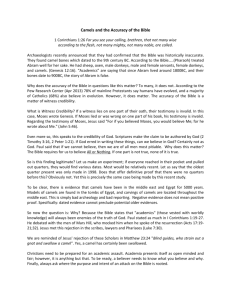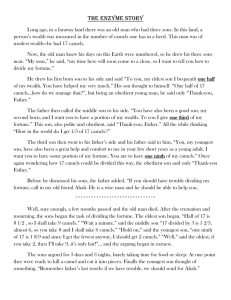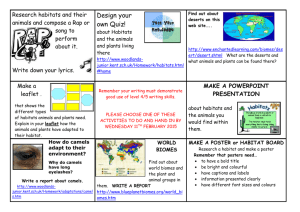Document 10465658
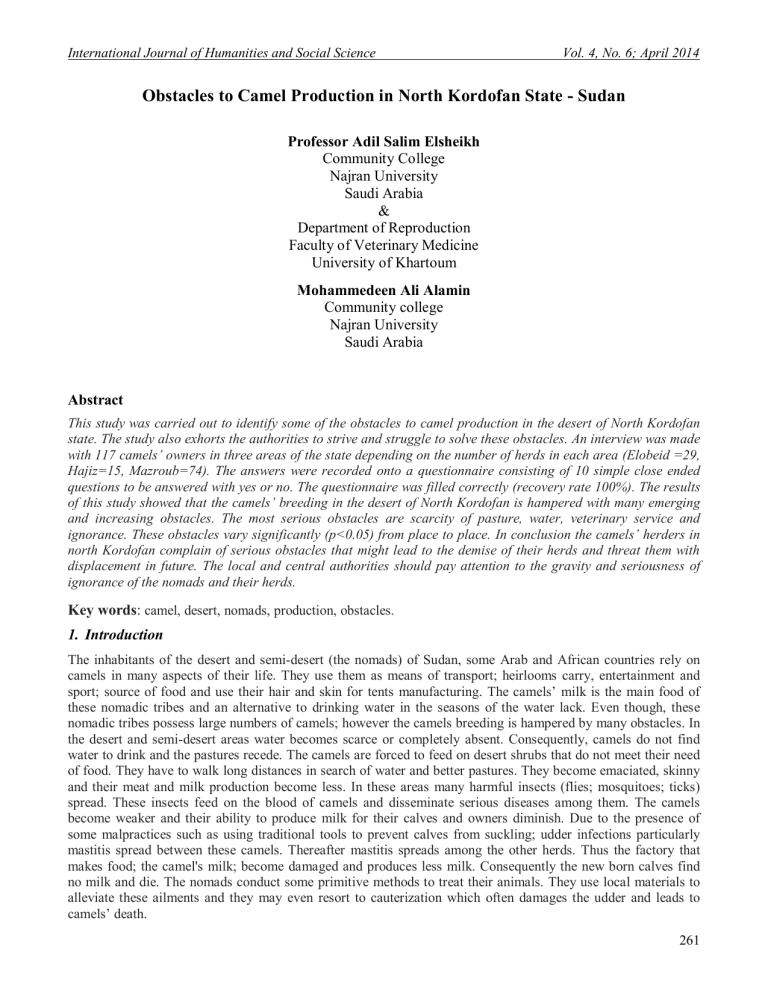
International Journal of Humanities and Social Science Vol. 4, No. 6; April 2014
Obstacles to Camel Production in North Kordofan State - Sudan
Professor Adil Salim Elsheikh
Community College
Najran University
Saudi Arabia
&
Department of Reproduction
Faculty of Veterinary Medicine
University of Khartoum
Mohammedeen Ali Alamin
Community college
Najran University
Saudi Arabia
Abstract
This study was carried out to identify some of the obstacles to camel production in the desert of North Kordofan state. The study also exhorts the authorities to strive and struggle to solve these obstacles. An interview was made with 117 camels’ owners in three areas of the state depending on the number of herds in each area (Elobeid =29,
Hajiz=15, Mazroub=74). The answers were recorded onto a questionnaire consisting of 10 simple close ended questions to be answered with yes or no. The questionnaire was filled correctly (recovery rate 100%). The results of this study showed that the camels’ breeding in the desert of North Kordofan is hampered with many emerging and increasing obstacles. The most serious obstacles are scarcity of pasture, water, veterinary service and ignorance. These obstacles vary significantly (p<0.05) from place to place. In conclusion the camels’ herders in north Kordofan complain of serious obstacles that might lead to the demise of their herds and threat them with displacement in future. The local and central authorities should pay attention to the gravity and seriousness of ignorance of the nomads and their herds.
Key words
: camel, desert, nomads, production, obstacles.
1.
Introduction
The inhabitants of the desert and semi-desert (the nomads) of Sudan, some Arab and African countries rely on camels in many aspects of their life. They use them as means of transport; heirlooms carry, entertainment and sport; source of food and use their hair and skin for tents manufacturing. The camels’ milk is the main food of these nomadic tribes and an alternative to drinking water in the seasons of the water lack. Even though, these nomadic tribes possess large numbers of camels; however the camels breeding is hampered by many obstacles. In the desert and semi-desert areas water becomes scarce or completely absent. Consequently, camels do not find water to drink and the pastures recede. The camels are forced to feed on desert shrubs that do not meet their need of food. They have to walk long distances in search of water and better pastures. They become emaciated, skinny and their meat and milk production become less. In these areas many harmful insects (flies; mosquitoes; ticks) spread. These insects feed on the blood of camels and disseminate serious diseases among them. The camels become weaker and their ability to produce milk for their calves and owners diminish. Due to the presence of some malpractices such as using traditional tools to prevent calves from suckling; udder infections particularly mastitis spread between these camels. Thereafter mastitis spreads among the other herds. Thus the factory that makes food; the camel's milk; become damaged and produces less milk. Consequently the new born calves find no milk and die. The nomads conduct some primitive methods to treat their animals. They use local materials to alleviate these ailments and they may even resort to cauterization which often damages the udder and leads to camels’ death.
261
© Center for Promoting Ideas, USA www.ijhssnet.com
The owners of these camels live in remote areas difficult to access and lack paved roads. These Bedouins suffer from neglect and lack of governmental facilities. In these areas there are no permanent veterinary health services to treat and vaccinate the herds of camels against epidemic diseases; despite the diligence of the veterinary authorities to provide some services. In addition to these obstacles that limit the camels’ production; camels are exposed to robbery that lead to the loss of camels and sometime human lives. If these obstacles are not curbed this enormous wealth will go away and the owners of camels will be displaced. Eventually they will be obliged to live in outskirts of cities and become a burden on the state. This study aims to identify some of the obstacles to camel production in the desert of North Kordofan state in Sudan. Furthermore, the study draws the attention of the concerned authorities to the gravity of ignoring the nomads and their herds.
2.
Previous Studies
Numerous studies have been conducted on the camels in the Sudan. These studies focused on the different diseases that infect camels. Ali et al. (2005) studied the epidemiology of diarrhoea in camel calves particularly the rotavirus infection. Khalafala et al.2010 studied the Pest Des Petitis Ruminants in camels. There are also studies on diseases that affect the genital tract of camel (Yagoub 2005). Also some studies have focused on the productive traits of camels (Darosa and Agab 2005). Other studies have focused on the udder infections in camels(Obeid et al. 1996; Agab and Abas 1998; Alamin et al. 2013, Alqurashi et al. 2013).Some studies have focused on parasitic infestations in camels especially mange and ticks((Musa and Osman 1990; Nayel and
Abusamra 1986; Musa et al. 1989).Another group of researchers studied the use of traditional means to prevent camels’ calves from suckling and their impact on the udder (Obeid et al 1996; Abdulrahman et al 2013).There are many studies that have focused on the diseases of camels and their productive capacity of meat and milks. The important of camels’ milk for human being health and nutrition was confirmed in the study of Schwartz and Dioli
(1992) and Wilson (1998) who authenticated that camels’ milk contains proteins, sugars, fats, mineral salts and vitamins very necessary for human health and nutrition. Also camels’ milk represents a major source of vitamin
C; a very important element for human health; which does not exist in the desert and semi-desert areas due to the lack of fruits and vegetables in these areas. Faye et al. (2011) indicated that the camels in Sudan are bred mainly to produce milk, which is consumed fresh or fermented. According to this study; the camels in Sudan produce less milk compared to those raised in farms in other countries. The study of Bakheit et al. (2008) showed that the milk production of a she-camel reared under traditional methods does not exceed 3.1 litres per day, while those bred under semi-intensive system produce up to 6.9 litres of milk per day.
3.
Study hypothesis
This study assumed that the camels bred for milk production in North Kordofan State of Sudan suffer from many obstacles that limit their production efficiency. Also the study hypothesized the existence of significant differences in the intensity of these obstacles from area to another.
4.
Study area and data collection
This study was carried out in North Kordofan state in Sudan, coordinates14° 22 ′ 0 ″ N, 29° 32 ′ 0 ″ E(Fig. 1). The area is almost a desert where minimal rain falls in autumn (July to October). The area is sandy with some valleys and seasonal water pools. The area is covered with various kinds of shrubs and few grasses. The population of the study was the owners of camels who live a nomadic life. The survey sample suffers illiteracy and were surveyed with a very simple survey instrument (questionnaire).The survey instrument contained 10 closed –ended questions to be answered with yes or no (Table 1). The questionnaire was distributed to 117 subjects of the study sample in three different localities. Namely Elobeid in the centre of the state (n= 29), Hajiz in the south (n= 15) and
Mazroub in the north (n= 74). Because the nomads cannot read nor they can write they were directly interviewed and all questionnaires were filled perfectly (recovery rate of 100%).
5.
Statistical analysis
The data were analysed with Chi- square (×
2
).Probabilities of P <0.05 were considered significant.
6.
Results
As shown in Table (1) 65 subjects of the study sample (55.1%) in the three districts agree with the assumption of the study that says there is scarcity of water and pastures.
262
International Journal of Humanities and Social Science Vol. 4, No. 6; April 2014
The number of the subjects in the areas of Elobeid and Mazroub who agree with this assumption significantly differs (p ˂ 0.05) from the number of those surveyed in Hajiz; where 93.7% of the subjects surveyed do not agree with it. The opinions of the subjects surveyed in the three areas differed significantly (p ˂ 0.05) about the presence of diseases among camels. The percentage of those who agreed to this assumption in Elobeid, Hajiz and Mazroub are 37.9%, 80.0% and 18.9%, respectively, with an average of 31.4%. The two assumptions of the presence of harmful insects and mastitis have been agreed upon by all the subjects of the study (100%). Regarding the hypothesis of the scarcity of veterinary services in these areas there is no significant difference (p ˃ 0.05) between the views of the subjects. The overall percentage of those who agree with this assumption was 85.6% or
101individuals of the total sample surveyed. The hypothesis that says that the camels in these areas are exposed to armed robbery and theft was not approved by 115 subjects surveyed (97.3%). Ninety-eight camel breeders
(83.1%) who participated in the study agreed that they use anti-sucking device to prevent calves from sucking to get more milk. However camel breeders in Hajiz are the least (p ˂0.0
5) users of this tool. The percentages of those who agree with the hypothesis that says camel breeders use antibiotics do not differ (p ˃0.05) and the overall mean is 57.7%. Those who use acaricides in the three areas differ significantly (p ˂0.0
5) with an overall rate of 85.6%.
The percent of those who agreed that they use traditional methods to treat their camels was only 20.3%.
7.
Discussion
This study confirmed that camels in North Kordofan state suffer scarcity of water and pastures particularly in the northern areas of the state. The camels are obliged to walk long distances in search of water and pasture. Thus the camels graze on desert shrubs which do not meet their nutritive needs and drink at long time intervals (several days). Consequently the camels’ nutritional status and productivity are adversely affected. Since the water is the greatest component of the milk its lack or scarcity in the desert and semi-desert areas reduces the ability of camels to produce milk and deprive the nomads of their main food the camels’ milk. This also will increase the rate of calves’ loss and deprive the camels’ breeders of renewing their herds in the future. Camels have the capacity to produce significant amount of milk if good management, pasture, feed additives and water source were provided to meet their daily needs (Faye et al. 2011). The camels of North Kordofan state suffer from diseases particularly the southern areas of the state represented by Hajiz, where the percentage of camels’ owners who complained of diseases was higher than that of northern areas (Elobeid and Mazroub). All the surveyed camels’ owners complained of ticks and harmful insects like mosquitoes and flies which adversely affect the health of their camels and consequently reduce their productivity. The spread of harmful insects was authenticated elsewhere
(Musa and Osman 1990; Nayel and Abu Samra 1986; Musa et al. 1989).
Also all camels’ owners complain of mastitis which was reported by many authors (Agab and Abbas 1998; Alamin et al. 2013; Alqurashi et al. 2013).
The rate of mastitis incidence in the camels was recorded as 21% of the total herd (Agab and Abbas 1998).
Mastitis damages the udder and disrupts its ability to produce milk (Obeid et al. 1996). This will aggravate the food scarcity (camels ’ milk) for both the Bedouins and their camels ’ calves. Also the study confirmed that
Bedouins use local anti- sucking device to prevent camel calves from sucking in order to obtain milk, but the least users are those of Hajiz. This tool exacerbates mastitis by leaving cuts, bruises and scratches that assist the bacteria to invade the udder (Abdurahman et al. 1995; Obeid et al. 1996).The low usage of camel owners of Hajiz for the anti-sucking device could be attributed to the good pastures in the area where she-camels can produce more milk enough for both human and calves. The study also confirmed that the Bedouins resort to local substances such as tar and cauterization to treat their camels especially mastitis. This type of treatment is expected to aggravate the case and lead to the damage of the udder ( Abdurahman et al. 1995; Obeid et al. 1996).
High percent of the surveyed camels ’ owners complained of shortage in veterinary services and extension. As the camels ’ breeders live a nomadic life ( Mohamed, 1992; Yagoub, 2003 ); the veterinary services such as vaccination, treatment and extension may be sparse or even absent because the nomads usually move to remote areas in searching of pasture and water where there are no paved roads that the mobile veterinary service can take.
A very high percentage of the interviewed camels ’ owners denied the spread of arm robbery and theft of camels.
However, the weapons which spread as a result of armed conflicts in the west and south of Sudan encourage a lot of aspirants to seize the Bedouin’s camels. The tribal customs of the camels’ herders prevent them from disclosing the security risks facing their camels. Because in their culture the valiant is the one who protects his camels and the coward is the one who seeks the assistance of the security authorities. No doubt in the remote areas of the Sudan there are tribal conflicts and security turmoil.
263
© Center for Promoting Ideas, USA www.ijhssnet.com
Thus in these areas armed robbery prevails and it might affect the camels as well as the life of their owners. Also the Bedouins do not know the scientific methods to combat harmful insects nor can they find a regular scientific treatment for their herds. They do not know the ways to prevent mastitis such as cleaning, disinfection of the udder and the milkman’s hands before and after milking. These obstacles collectively lead to a decline in the production of camels’ milk. Consequently those who live in the desert and semi-desert areas suffer from shortage of an important food source.
The camel owners widely use antibiotics and pesticides to treat their camels. If we consider the scarcity of veterinary service; that appeared from this survey; and the illiteracy in these areas, the non-scientific use of antibiotics and pesticides is rampant and it threatens the health of the camels’ herders, their animals, the consumers of the camels’ products as well as the environment; because of its known adverse effects on human and animal health. Although the percentage of those who use traditional methods to treat their herds is low in this survey; it remains one of the serious constrains that affects camel production.
8.
Conclusions and recommendations
1.
Sudan is endowed with a huge camel population which might reach 5 million according to recent estimation; which if conserved scientifically can contribute significantly to the national economy.
2.
North Kordofan state of Sudan is one of the areas where camels are bred intensively. However, those who breed these camels are illiterate nomads and their area suffers shortage of pasture and water. Therefore the concerned authorities should struggle very hard to alleviate illiteracy. Furthermore they should strive to curb the problems of pasture and water scarcity by water harvesting during rainy seasons and digging artesian wells all over the area where camels graze. Additionally they authorities should think and try hard to create an attractive environment to resettle the nomads. If resettling deemed impossible; mobile schools, mobile health care clinics, mobile security service, mobile entertainment facilities as well as mobile markets; that could move wherever the pastoralists move; should be availed.
3.
From this study the camels’ herders, complain of diseases particularly mastitis and tick infestation, they use tradition method to treat their animals with no adequate veterinary services to combat them. Despite the efforts of the ministry of animal resources to deliver veterinary services for each animal owner in
Sudan they should make an additional effort to expand the umbrella of these services to meet the demands and wishes of the camels’ breeders. Therefore veterinary authorities must offer veterinary service of special nature to suit the nomadic life. They should provide mobile veterinary clinics; that can move with pastoralists from one place to another; for the provision of the veterinary services in the day and night.
Another solution for this problem is to train individuals from these nomadic societies to be paraveterinarians to serve their community and communicate with veterinary authorities in case of disease outbreaks.
4.
The camels’ owners strive very hard to have more milk from their camels; however under the scarcity of pasture and water the ability of she-camels to produce milk diminishes. Thus camels’ owners use antisucking device to prevent calves from sucking. By this they can obtain good milk but they might lose their calves. Also, using of tar and other traditional means may cost them the animals’ udders. This situation should be addressed by expansion of the veterinary extension services to teach them how to use sound means to get more milk and rear their camel calves properly.
5.
The Bedouins must be educated to know the enormous risks that may occur as a result of the nonscientific use of antibiotics and pesticides and their serious consequences on human, animal and the environment. All the media outlets, newspapers, radio, television and videos as well as mobile cinema should be employed to spread the culture of scientific dealing with such materials.
264
International Journal of Humanities and Social Science Vol. 4, No. 6; April 2014
References
Abbas, B. (1993). Clinical observation in field case of camel calf diarrhoea. J. Camel Sci., 1: 47-51.
Abdurahman, O. S. H.; Aga, H.; Abbas, N. and Astom, G. (1995). Relation between udder infection and somatic cells in Camelus dromedarius milk. Acta Vet. Scand., 63(4): 424-431.
Nayel, N. M. and Abu-Samra M.T. (1986).Experimental infection of the one humped camel ( Camelus dromedaries) with Sacoptes scabaiei var. cameli and S. scabiei var.ovis. Ann Trop Med Parasitol. 80 (5);
553 – 561.
Agab, H.and Abas, B.(1998). Epidemiological studies on camel disease in eastern Sudan. Camels’newsletter.
14:53-57.
Alamin, MA, Alqurashi, AM, Elsheikh, AS. And Yasin, TE. Mastitis incidence and bacterial causative agents isolated from lactating she-camel ( Camelus dromedaries ), IOSR-JAVS., 2013; Vol. 2, (3) pp. 07-10.
Ali Y H, Khalafalla A I and El Amin M A 2005 Epidemiology of camel calf diarrhoea in Sudan: seroprevalence of camel rotavirus infection. Journal of Animal and Veterinary Advance. 4: 393-397.
Alqurashi, AM, Alamin, MAs, Elsheikh, AS. And Yasin, TE. Sensitivity of bacterial isolates from mastitic Shecamel ( Camelus dromedaries ) to antibiotics, Journal of American Science 2013;9(4). http://w ww.jofamericanscience.org
Bakheit S A, Abu-Nikheila A M, Kijora C and Faye B 2008 The impact of farming system on Sudanese Camel milk production', Proceedings of WBC/ICAR 2008 Satellite meeting on camelid reproduction' , Budapest
(Hungary), 12-13 July 2008, P. Nagy and G. Huscenicza (Eds), pp 88-90.
Darosa, A. E. M. and Agab, H. (2005). Studies on some camel ( Camelus dromedarius ) production traits, health and constraints in Butana area, Sudan. Online.
Faye B.(2011). Camel in Sudan: future prospects. Livestock Research for Rural Development. 23,
Online:http://www.Irrd.org/Irrd23/10/faye23219.htm
Khalafalla A I, Saeed I K, Ali Y H, Abdurrahman M B, Kwiatek O, Libeau G, Obeida A A, and Abbas Z 2010
An outbreak of peste des petits ruminants (PPR) in camels in the Sudan. Acta Tropica 116: 161-165.
Mohammed, B. A. A. (1992). Aerobic Bacteria of lymph nodes of the dromedary camel MSc thesis, University of
Khartoum.
Musa, T. M. and Osman, M. O. (1990). An outbreak of a suspected tick paralysis in one-humped camel in Sudan.
Revue d’Élevage et de Médicine Vétérinaire des Pays Tropicaux , 43(4): 505-510.
Musa, T. M.; Ibrahim, M. A. and Taha, O. T. (1989). Observation on Sudanese camel nasal myasis by the larvae of Cephalopinatitllator . Revue d’Élevage et de Médicine Vétérinaire des Pays Tropicaux , 42(1): 27-31.
Obied, A. I. M.; Bagadi, H. O. and Mukhtar, M. M. (1996). Mastitis in Camelus dromedarius and the somatic cell count of camel’s milk. Res. Vet. Sci., 61(1): 55-58.
Schwartz, H. J. and Dioli, M. (1992). Introduction of the camel ( Camelus dromedarous ) in eastern Africa. In :
Schwartz, H. J. and Dioli, M. (eds). The one humped camel in eastern Africa. A pictorial guide to diseases healthcare and management. Verlag Jösef Margraf, Weikersheim, F. R.
Germany, pp 1-9.
Wilson, R. T. (1998). The camels. The Tropical Agricultural Series, London and Basingstoke, UK. McMillan
Education Ltd., published in co-operation with the CTA, Wageningen, the Netherlands.
Yagoub, O.(2005). Bacterial diseases of the reproductive system of camels ( Camelus dromedarius ) in Eastern
Sudan. Journal Animal and Veterinary Advance 4: 642-644.
Yegoub, I. A. (2003). Studies on epidemiology, characterization and pathogenicity of Eimeria species in Sudanese camels. PhD thesis, University of Khartoum.
265
© Center for Promoting Ideas, USA www.ijhssnet.com
Fig. (1). North Kordofan State map (Coordinates: 14° 22 ′ 0 ″ N, 29° 32 ′ 0 ″ E).
Table (1). Assumption questions responses results.
Questions
1.
My camels suffer from scarcity of water and pasture
Number of owners who answered with yes (%)
Elobeid Hajiz
17 (58.6) a
01 (6.7) b
Mazroub
47 (63.5) a
Total
65 (55.1)
2.
My camels suffer from diseases
5.
My camels are exposed to armed
11 (37.9) a
12 (80.0) b
14 (18.9) c
37 (31.4)
3.
My she-camels suffer from mastitis 29 (100)
4.
I receive no veterinary services 25 (86.2)
0 1 (3.5)
15 (100.)
11 (73.3)
01 (6.7)
73 (100)
66 (89.2)
0 (0.00)
117 (100)
101 (85.6)
02 (2.7) robbery and theft
6.
My camels suffer ticks infestation
7.
I use anti-sucking devices to get more milk
8.
I treat my diseased camels with antibiotics
9.
I treat my diseased camels with tar and cauterization?
10.
I use acaricides to combat ticks
29(100)
28 (96.6)
a
19 (65.5)
03 (10.3)
29 (100)
a
15 (100)
07 (46.7)
b
8 (50.0)
04 (26.7)
14 (93.3)
b
73 (100)
63 (85.1)
a
42 (56.8)
17 (23.0)
58 (78.4)
c
117 (100)
98 (83.1)
68 (57.6)
24 (20.3)
101 (85.6) a-e
Values with different superscripts in the same raw differ (p ˂0.05)
266
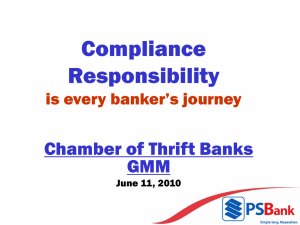
![KaraCamelprojectpowerpoint[1]](http://s2.studylib.net/store/data/005412772_1-3c0b5a5d2bb8cf50b8ecc63198ba77bd-300x300.png)

